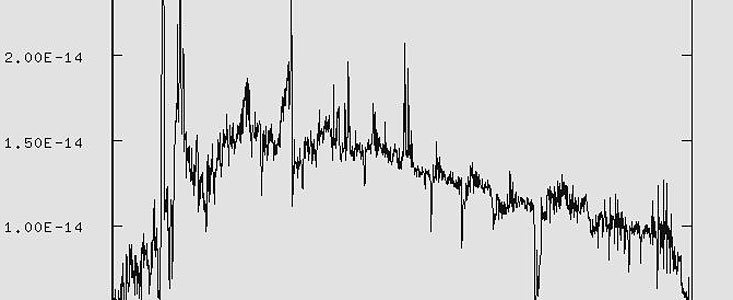Press Release
First Spectrum of Comet C/1996 B2 (Hyakutake)
11 February 1996
This diagramme shows the first spectrum obtained of comet C/1996 B2 (Hyakutake), which is expected to pass near the Earth in late March 1996. It was taken by Tomaz Zwitter, visiting astronomer at the ESO La Silla Observatory from the University of Ljubljana, Slovenia. It has been flux- [(erg/s/cm2/A) within 2x14 arcsecond slit centered on comet] and wavelength- [Angstrom] calibrated.
The following description of this spectrum was published on IAU Circular 6306 (February 9, 1996)
T. Zwitter and H. Mikuz, University of Ljubljana; and U. Munari and M. Rejkuba, Asiago Observatory, communicate: A spectrogram (range 340-910 nm) of C/1996 B2 was obtained at the European Southern Observatory's 1.5-m telescope (+ Boller & Chivens spectrograph + CCD) on Feb. 8.2 UT. The slit (width 2 arcsec, length 14 arcsec) was positioned on the comet nucleus. The reflected solar spectrum accounts for the vast majority of the recorded flux, with all major absorption lines markedly visible. The strongest cometary emission is from CN(0,0) at 388 nm, followed by the C3 complex at 405 nm. The strongest C2 Swan band is that of (0,0) at 516 nm, followed by that of (1,0) at 474 nm, with that of (2,0) at 438 nm being barely detectable. The CN(0,1) 422-nm band is in moderate emission, while no cometary NaI D emission is observed.
At the time of this observation, the comet was at a distance of 1.55 AU (232 million kilometres) from the Earth and 1.89 AU (283 million kilometres) from the Sun.
The recorded spectrum is typical for a comet at this heliocentric distance.
About the Release
| Release No.: | eso9611 |
| Legacy ID: | Photo 12/96 |
| Name: | C/1996 B2, Comet Hyakutake, Spectrum |
| Type: | Solar System Solar System : Interplanetary Body : Comet |
| Facility: | ESO 1.52-metre telescope |
| Instruments: | Boller and Chivens Spectrograph |

